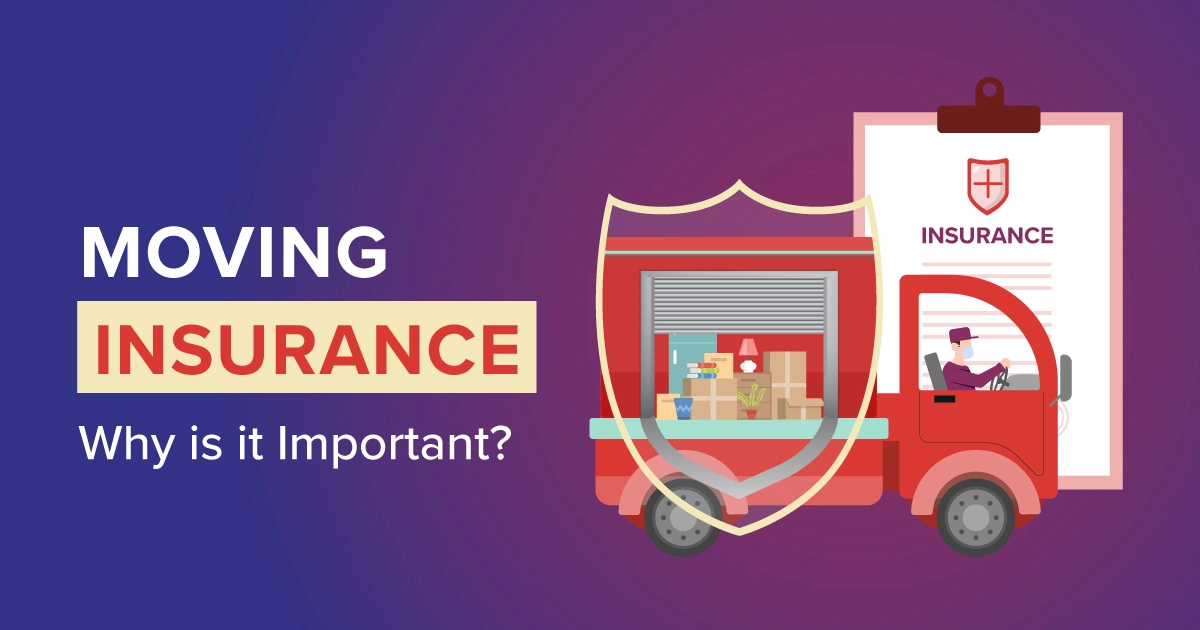Understanding Moving Insurance
Unpacking your boxes post-move to realize that you cannot find certain items can be incredibly frustrating. Even worse, you find that the journey caused some damage to your belongings.
Accidents, unexpected circumstances, and the inherent risks of transportation are all too common. That’s why securing insurance is an essential first step in every move.
In this guide, we’ll cover the different types of moving insurance to help you better understand your coverage choices.
We want you to feel empowered to make well-informed decisions for your next move without the added unnecessary stress.
What Is Moving Insurance?
Think of moving insurance as a shield for your cherished belongings. It provides you with specialized coverage to protect them from accidents, damages, and unforeseen circumstances.
Essentially, moving insurance helps make sure you don’t bear the full brunt of any unexpected mishaps during your move.
Choosing Your Moving Company or Insurance Provider
First things first, selecting the moving company or insurance provider you want to go with is key.
But before you settle, it’s important to have a good understanding of the insurance your ideal company offers.
With so many options available, navigating through the various types of coverage can be overwhelming.
From basic plans to comprehensive packages, each policy comes with its unique set of features and protections.
Types of Moving Insurance Coverage
Released Value Protection
| Pros | Cons |
| Cost: Released Value Protection is often included in the moving cost or available at a minimal fee. | Limited Coverage: Provides minimal coverage (usually around $0.60 per pound per item). |
| No Deductible: Typically, no deductible is required. | Lack of Full Value: Does not cover the full value of your items. |
| Default Option: It may be the default or basic coverage provided by moving companies. | Limited Liability: The moving company’s liability is based on weight, not the actual value of the items. |
Most moving companies offer a standard form of coverage at no additional cost, known as released value protection.
But, there are limits to it: it usually covers only about $0.60 per pound of the damaged items. So, although this option is wallet-friendly, it may not pay for the full replacement of your valuable belongings.
Declared Value Protection
| Pros | Cons |
| Cost: Generally less expensive than Full Value Protection. | Limited Coverage: The coverage is based on the declared value of your items, not the actual replacement cost. |
| Flexibility: Allows you to declare a value for your shipment within certain limits. | Depreciation: Items may be subject to depreciation, and you might not receive the full declared value. |
| No Deductible: Typically, there’s no additional deductible. | Valuation Process: The valuation process can be complex, and understanding how it applies to each item is important. |
| Default Option: Often included as a standard option in moving contracts. | Not Full Replacement Cost: The payout may not cover the full replacement cost of damaged or lost items. |
Moving companies also typically provide another type of insurance known as declared value protection.
When you select this coverage, you inform the moving company about the value of your belongings. Then, the company will calculate your coverage based on the values you provided.
This type of moving insurance is no doubt an improvement over your basic coverage.
However, it’s crucial to understand the limitations and exclusions before obtaining it.
Full Value Protection
| Pros | Cons |
| Comprehensive Coverage: FVP covers the full value of damaged or lost items. | Cost: FVP tends to be more expensive than other options. |
| Repair or Replacement: The moving company is responsible for repairing or replacing damaged items. | Deductible: There may be a deductible, and it could still leave you with out-of-pocket expenses. |
| Peace of Mind: Provides peace of mind, knowing that your belongings are fully protected. | Valuation Process: Some items may be subject to depreciation, and the valuation process can be complicated. |
Some moving companies also offer full-value protection insurance. Although rare, this type of insurance covers any and all loss or damage to your belongings.
Third-Party Insurance
| Pros | Cons |
| Flexible Coverage: You can choose the coverage amount based on your needs. | Additional Cost: You may need to pay extra for third-party insurance. |
| Broader Coverage: Can provide coverage for specific high-value items or unique circumstances. | Claims Process: The claims process may involve coordination between the moving company and the insurance provider. |
| Tailored Protection: This allows you to tailor coverage to your specific needs and concerns. | Policy Conditions: Policies may have specific conditions and exclusions. |
Beyond the offerings provided by your moving company, consider getting third-party insurance.
These alternative policies bring you a new level of protection by providing usually higher coverage limits.
Third-party insurance can be a lifesaver when you need it. But before you choose a third-party insurer, do your research.
Check their reputation, read customer reviews, and ensure their claims process is reliable.
Homeowners Insurance Coverage
| Pros | Cons |
| Existing Coverage: You may already have coverage for your belongings. | Limits and Deductibles: Coverage may have limits and high deductibles. |
| Cost-Effective: No additional cost for moving insurance. | Exclusions: Some policies may exclude certain damage or losses during a move. |
| Simplicity: No need for a separate policy; coverage is already in place. | Notification: You may need to notify your insurance provider about the move. |
| Broad Coverage: Policies may cover a wide range of perils, including theft and damage during transportation. | Transit Limits: Some policies may limit coverage during transit or exclude certain property types. |
| No Separate Claims Process: You can use the existing claims process of your home insurance. | Coverage Adjustments: If using home insurance, the coverage may be subject to adjustments based on the terms of your policy. |
Consider also tapping into the protection already provided by your homeowner’s insurance plan. This is an easy way to add an extra layer of coverage for your belongings during the move.
Tips for Peace of Mind During Your Move
Moving to a new home can be an exciting time, but it can also bring about lots of stress and anxiety. Obtaining reliable insurance can help ease the challenges of moving.
Beyond the physical protection of your belongings, insurance provides one valuable intangible asset.
Below are just some of the psychological benefits of having insurance for your move:
Reduced Anxiety and Stress
The mere thought of potential loss or damage to your most cherished possessions can be a significant source of stress.
Having an insurance plan in place to cover the uncertainties can significantly reduce anxiety.
It provides a safety net and allows you to focus on the positive aspects of your move rather than worrying about the what-ifs.
Confidence in the Face of Uncertainty
The process of moving, of course, inherently comes with some degree of uncertainty.
Whether it’s the transportation logistics, the condition of your items upon arrival, or any unforeseen events, Moving insurance ensures that in case of any unexpected mishaps, you have a plan to minimize the impact.
Emotional Attachment to Belongings
Many possessions hold sentimental value, and just the thought of losing or damaging them can be emotionally distressing.
Moving insurance provides money for your damaged items and assures that if something goes wrong, you can take steps to fix or replace them.
This knowledge definitely helps to preserve your emotional well-being throughout the moving process.
Focus on the Positive
Insurance allows you to redirect your focus from the potential negatives to the positive aspects of your move.
It helps you feel at ease so you can enjoy new things like exploring your neighborhood or looking for a new job close to home.
The psychological benefits no doubt extend far beyond the physical protection of your belongings.
Moving insurance helps you to feel calm and confident while moving to your new abode.
How to Choose the Right Moving Insurance
We know picking the right moving insurance can be overwhelming. Rest assured, here are some of our tips to find the perfect plan.
Take a Home Inventory
Channel your inner Marie Kondo and take stock of all your belongings. Identify those prized possessions that deserve a little extra TLC and coverage.
Understand Your Coverage Limits
Be sure to acquaint yourself with the coverage limits and any exclusions that might be lurking in the fine print.
Being well-versed in the nitty-gritty will help you select the policy that aligns perfectly with your needs.
Research Moving Companies
Opt for a reputable team with a track record of excellent service and transparent insurance options. Be sure to read customer reviews and ask for recommendations.
Get a Quote
Securing a quote beforehand is your personal insurance policy against any kind of moving-day drama.
Get a quote or determine how many boxes you need with our packing materials calculator, all for free.
Ask The Tough Questions
Put on your journalist hat and ask your chosen moving company about their insurance plans and policies.
Before setting anything in stone, be sure to clear up any of your lingering doubts or concerns.
A smooth move is not just about packing boxes; it’s about maintaining peace of mind in the process.
Factors to Consider When Selecting Moving Insurance
Coverage Limits
When assessing insurance policies (and to get the most bang for your buck), try and strive for comprehensive coverage.
Be sure to compare the different types of coverage options offered by different moving companies and or insurance providers.
Also, watch out for any sneaky limits on specific items or categories to avoid unexpected complications. This way, you’ll be able to confidently select a provider that aligns best with your financial needs.
Deductibles and Exclusions
Don’t forget to examine the deductible structures of different providers, too. Some may have fixed deductibles, while others may offer flexible options.
Opt for a provider that allows you to customize coverage based on your unique needs and circumstances.
By the way, a lower deductible equals a higher upfront cost but saves you money in the long run, especially when making a claim.
Be sure to check your home insurance policy’s exclusions and buy extra if necessary.
Claims Process
Investigate the efficiency of the claims process with different providers. Acquaint yourself with the details of reporting procedures and timelines.
Also, try reading up on the experiences of other customers to gauge the provider’s responsiveness.
A streamlined and transparent claims process is key. Plus, already knowing how to address damaged goods before your move can greatly speed up any necessary resolution processes.
Licensing and Credentials
Make sure to check that the insurance providers you are considering have proper licensing and regulation. Check for any industry certifications and credentials to guarantee they are legit.
Customer Reviews and Ratings
Look into the customer reviews and ratings of different moving companies and insurance providers.
Pay attention to feedback on the claims process, customer service, and overall satisfaction. A provider with positive reviews is more likely to offer you the reliable coverage you’re looking for.
Additional Services
Inquire about any additional services or coverage options offered by the moving company or insurance providers.
Some may include services like temporary storage or protection against specific risks that others do not provide.
Documentation Needed for a Moving Insurance Claim
When filing a moving insurance claim, proper documentation is crucial to ensure a smooth and efficient process.
Here is the paperwork and proof you’ll need to prepare:
Inventory List
Create a detailed inventory list for all items you’re moving. This list should include descriptions, quantities, and the condition of each item. It serves as a baseline for assessing damages.
Photographic Evidence
Take clear photographs of your belongings before the move. These images serve as visual proof of the initial condition of your items.
They are helpful for comparing if there are any damages.
Bill of Lading
The bill of lading is a document issued by the moving company. It serves as a contract and a receipt for all of your belongings.
Keep a copy of this document, as it outlines the terms and conditions of your move.
Insurance Policy
This comes as a given, but have a copy of your moving insurance policy readily accessible. Be sure to familiarize yourself with the terms and coverage limits to understand what is eligible for a claim.
Proof of Value
For high-value items, provide proof of their worth through receipts, appraisals, or any relevant documentation. This helps establish the value of the items in question.
Condition Reports
If the moving company conducts a pre-move survey or assessment, retain any condition reports they provide. These documents may include notes on the condition of your items before the move.
Repair Estimates
Be sure to obtain estimates from reputable professionals for the cost of repairs for your damaged goods. This information supports your claim for reimbursement.
Communication Records
Maintain records of any communication with the moving company regarding damages. This includes emails, letters, or notes detailing your concerns and the company’s responses.
Witness Statements
If you can, gather statements from any witnesses present during the move. Or any individuals who can attest to the condition of your items before and after the relocation.
Tips for a Smooth Claim Process
Time-Sensitive Filing
Be sure to adhere to the specified timeframe for filing a claim as outlined in your insurance policy. Timely submission is critical, and failure to meet deadlines may result in claim denial.
Claim Form
When filling out the claim form, make sure to provide accurate and detailed information for a quick review.
Keep Copies
Make duplicates of all documents submitted for your records. Having copies ensures that you can provide additional information if requested during the claims process.
By assembling and organizing these documents, you increase your chances of a successful moving insurance claim.
FAQs About Moving Insurance
What Does Basic Carrier Liability Cover?
Basic carrier liability typically covers a basic level of protection based on the weight of your items.
Understanding the extent of this coverage is crucial to assessing if additional insurance is necessary.
What Considers an Item High-Value?
For items of significant value, it’s essential to establish their worth through receipts, appraisals, or any relevant documentation.
Ensuring adequate coverage involves knowing how to prove the value of such items.
Is Moving Insurance Mandated by Law?
In Canada, there is no federal law that requires you to have moving insurance.
What Does Coverage Exclude?
Typical exclusions from moving insurance include damages from natural disasters or items that you packed yourself.
Knowing the exclusions in your moving insurance policy helps to anticipate potential risks.
Can I Purchase Insurance Directly, or Is It Included in the Moving Company’s Quote?
Consult your moving company to confirm if pricing includes insurance. Understanding the billing structure helps you budget appropriately for your move.
How Do I Submit an Insurance Claim?
Familiarize yourself with the steps involved in the claims process listed in your insurance policy.
Knowing how to make a claim makes resolving any potential issues during your move a whole lot easier.
Are There Various Coverage Levels Available?
Check the various coverage options offered by your insurance provider and or moving company. Be sure to choose a protection level that suits your specific needs.
What Happens If the Moving Company Loses Items During My Move?
Understand the procedures in place if items go missing during your move. This information is crucial for mitigating any of the potential risks and ensuring adequate protection of your belongings.
Is Coverage Provided for Items Packed by The Customer?
Clarify with your moving company whether your insurance coverage extends to items that you packed yourself.
Knowing the limitations regarding self-packed items can help you make an informed decision about the moving process.
Is It Possible to Modify My Insurance Coverage Once the Move Has Already Started?
Be sure to ask your moving company or insurance provider about the flexibility of your coverage. This will help you assess whether you can make adjustments once the moving process is underway.
Conclusion
The question of whether moving insurance is actually beneficial is worthwhile to consider.
After delving into the intricacies of coverage options and claims processes, the answer ultimately depends on your unique circumstances.
Yes, moving insurance protects your belongings and offers financial security in case of damage or loss.
However, whether it’s worth it depends on factors like possession value, moving distance, and coverage offered by the company.
Consider getting comprehensive coverage if you have high-value items or are making a long-distance move.
But if your move is local with minimal risk, your moving company’s basic coverage may be sufficient.
Deciding on moving insurance involves balancing your budget and considering how much you value protecting your belongings.
To make an informed choice, consider the potential risks, understand policy terms, and factor in your specific needs.


















